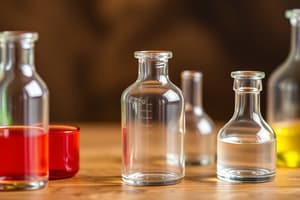Podcast
Questions and Answers
A compound is found to contain 50% element X and 50% element Y by mass. The atomic mass of X is twice that of Y. What is the empirical formula of this compound?
A compound is found to contain 50% element X and 50% element Y by mass. The atomic mass of X is twice that of Y. What is the empirical formula of this compound?
- XY₂
- X₂Y₂
- XY (correct)
- X₂Y
Which of the following molecules contains the greatest number of atoms?
Which of the following molecules contains the greatest number of atoms?
- One molecule of dimethyl ether (CH₃OCH₃)
- One molecule of propane (C₃H₈)
- One molecule of ethanol (C₂H₅OH)
- One molecule of butane (C₄H₁₀) (correct)
Which of the following correctly describes the relationship between molecular and empirical formulas?
Which of the following correctly describes the relationship between molecular and empirical formulas?
- The molecular formula and empirical formula are always identical.
- The molecular formula represents the simplest ratio of atoms, while the empirical formula represents the actual number of atoms.
- The empirical formula is always a whole number multiple of the molecular formula.
- The molecular formula is always a whole number multiple of the empirical formula. (correct)
An unknown compound has a molecular mass of 60 u and its empirical formula is CH₄N. What is its molecular formula?
An unknown compound has a molecular mass of 60 u and its empirical formula is CH₄N. What is its molecular formula?
What is the molecular mass of sulfuric acid (H₂SO₄)? (Atomic masses: H = 1 u, S = 32 u, O = 16 u)
What is the molecular mass of sulfuric acid (H₂SO₄)? (Atomic masses: H = 1 u, S = 32 u, O = 16 u)
Which of the following statements accurately reflects the law of conservation of mass?
Which of the following statements accurately reflects the law of conservation of mass?
According to the law of constant proportions, which statement is correct regarding the composition of water?
According to the law of constant proportions, which statement is correct regarding the composition of water?
What is a key postulate of Dalton's atomic theory?
What is a key postulate of Dalton's atomic theory?
Which of the following discoveries contradicted a key postulate of Dalton's atomic theory?
Which of the following discoveries contradicted a key postulate of Dalton's atomic theory?
An atom's identity is primarily determined by the number of which subatomic particle?
An atom's identity is primarily determined by the number of which subatomic particle?
What primarily determines the atomic mass of an atom?
What primarily determines the atomic mass of an atom?
An element 'X' has an atomic number of 16. How many valence electrons does it have?
An element 'X' has an atomic number of 16. How many valence electrons does it have?
Magnesium (Mg) has an atomic mass of 24u. Approximately how many times heavier is a magnesium atom compared to a hydrogen atom?
Magnesium (Mg) has an atomic mass of 24u. Approximately how many times heavier is a magnesium atom compared to a hydrogen atom?
Flashcards
Molecule of Element
Molecule of Element
A molecule containing only one type of atom.
Molecule of Compound
Molecule of Compound
A molecule containing two or more different types of atoms.
Molecular Mass
Molecular Mass
The sum of the atomic masses of all atoms in a molecule.
Ions
Ions
Signup and view all the flashcards
Empirical Formula
Empirical Formula
Signup and view all the flashcards
Law of Conservation of Mass
Law of Conservation of Mass
Signup and view all the flashcards
Law of Constant Proportion
Law of Constant Proportion
Signup and view all the flashcards
Dalton's Atomic Theory (part 1)
Dalton's Atomic Theory (part 1)
Signup and view all the flashcards
Dalton's Atomic Theory (part 2)
Dalton's Atomic Theory (part 2)
Signup and view all the flashcards
Dalton's Atomic Theory (part 3)
Dalton's Atomic Theory (part 3)
Signup and view all the flashcards
Dalton's Atomic Theory (part 4)
Dalton's Atomic Theory (part 4)
Signup and view all the flashcards
Atom
Atom
Signup and view all the flashcards
Molecule
Molecule
Signup and view all the flashcards
Study Notes
- The concept of atoms was initially proposed by ancient Indian and Greek philosophers, with the word 'atom' derived from the Greek term meaning indivisible
- Modern understanding has evolved, revealing that atoms are divisible into subatomic particles
Laws of Chemical Combination
- Antoine Lavoisier proposed the Law of Conservation of Mass
- The Law of Conservation of Mass, states that mass is neither created nor destroyed in a chemical reaction, with the total mass of reactants equaling that of products
- Joseph Proust proposed the Law of Constant Proportion (Definite Proportions)
- The Law of Constant Proportion (Definite Proportions) states that a chemical compound always contains the same elements in the same proportion by mass
- In water, the mass ratio of hydrogen to oxygen is consistently 1:8
Dalton’s Atomic Theory
- John Dalton proposed the Atomic Theory in 1808.
- Matter consists of tiny particles called atoms
- Atoms are indivisible and indestructible according to the theory
- All atoms of a given element are identical in mass and properties
- Atoms of different elements have different masses and properties
- Compounds form through the combination of atoms of different elements in fixed, simple, whole-number ratios
- Chemical reactions involve the rearrangement of atoms, not their creation or destruction
Limitations of Dalton’s Atomic Theory
- The theory does not account for subatomic particles, contradicting the indivisibility of atoms, disproved by the discovery of protons, electrons, and neutrons
- It doesn’t account for isotopes; elements can have different atomic masses
Atoms
- The smallest unit of an element retains the properties of that element
- Atoms consist of subatomic particles: protons, neutrons, and electrons
- Protons and neutrons reside in the nucleus, with electrons orbiting around it
- Atomicity is 1 for single-element, monoatomic atoms
Valency
- Valence electrons are those in the atom's outermost orbit
- An atom's valency is determined by its ability to gain, lose, or share valence electrons to complete its octet
Atomic Mass
- An atom's mass is primarily due to protons and neutrons
- Electrons contribute negligible mass
- One atomic mass unit (amu) is defined as one-twelfth the mass of a carbon-12 atom
Molecules
- A molecule comprises two or more atoms chemically bonded together
- Molecules can be elements, and contain the same atoms (e.g., O₂) or compounds (e.g., H₂O)
- Molecules of elements contain atoms of the same (Homo atomic) types of elements
- Diatomic molecules have an atomicity, number of atoms present in the molecule, of 2, such as H2,O2,Cl2
- O3 is Triatomic with an atomicity of 3
- P4 is tetra atomic with an atomicity of 4
- Molecules of a compound contain atoms of two or more different types (Hetero atomic) of elements
- CO, HCl, NaCl are diatomic
- CO2,H2O are triatomic
- NH3 is tetra atomic
- The molecular formula represents the number and type of atoms in a molecule
Molecular Mass
- The sum of the atomic masses of all atoms in a molecule.
- To calculate add the atomic masses of the constituent atoms in the molecular formula
- The molecular mass of H2O = (2 × Mass of one H-atom) + (Mass of one O-atom) = (2 × 1) + 16 = 18u
Ions
- Atoms or groups of atoms with a net electric charge due to the loss or gain of electrons
- Cations are positively charged ions, e.g., Na⁺
- Anions are negatively charged ions, e.g., Cl⁻
Chemical Formulae
- Represent the composition of molecules and compounds
- Empirical formulas show the simplest whole-number ratio of atoms in a compound
- Molecular formulas show the actual number of atoms of each element in a molecule
Writing Chemical Formulae
- Write the symbol of the elements involved
- Write the valency of each element
- Cross-over the valency numbers to balance the charges
Studying That Suits You
Use AI to generate personalized quizzes and flashcards to suit your learning preferences.



